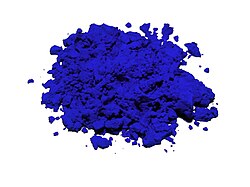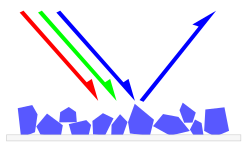Pigment


A pigment is something that is added to something else to give it color. Natural pigments can come from just about anything. Pigments can be made from animals, plants, rocks and minerals or even the ground itself, for example clay plus salts. Pigments can also be created by people.
An example of a pigment is ultramarine. It is a powder found in nature. It adds a blue color to paints and dyes.
The first synthetic dye was aniline. Aniline is an organic chemical compound produced in two stages from benzene. It gives a mauve color which was much used for dyeing clothes in the 19th century. It was invented in 1856 by William Henry Perkin. Apparently, it gave a brilliant fuchsia color when first applied, but fades rapidly to mauve.[1]
Pigment Media
Girl with a Pearl Earring by Johannes Vermeer (c. 1665).
The Milkmaid by Johannes Vermeer (c. 1658). Vermeer was lavish in his choice of expensive pigments, including lead-tin yellow, natural ultramarine, and madder lake, as shown in the vibrant painting.
Miracle of the Slave by Tintoretto (c. 1548). The son of a master dyer, Tintoretto used Carmine Red Lake pigment, derived from the cochineal insect, to achieve dramatic color effects.
References
- ↑ Druding, Susan C. 1982. Dye history from 2600 BC to the 20th century. [1] Archived 2020-09-23 at the Wayback Machine
+{{{1}}}−{{{2}}}






